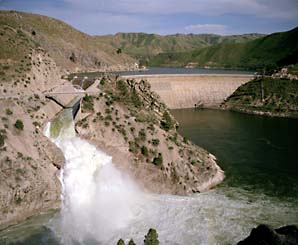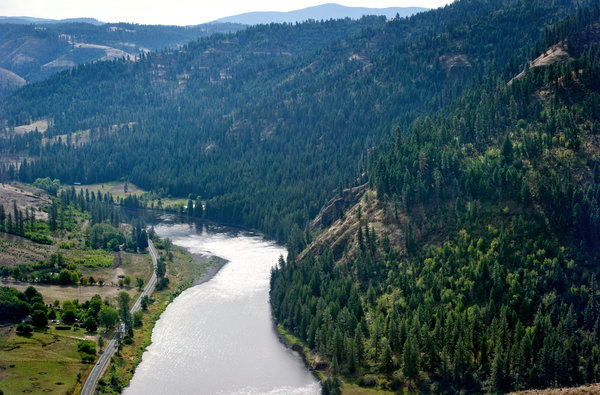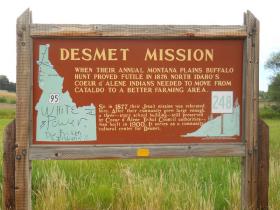Tag: Idaho
Idaho Sockeye Salmon Success Could Be A Blueprint
Approach could be used for other extinction fights
By Keith Ridler, Associated Press
BOISE, Idaho — Strategies used to bring back from the brink of extinction a population of central Idaho sockeye salmon have been so successful they could be used as a blueprint to prevent other extinctions, fisheries biologists say.
Thomas Flagg of the National Oceanic and Atmospheric Administration and Paul Kline of the Idaho Department of Fish and Game published their findings earlier this month in the journal Fisheries.
Scientists said a key strategy has been maintaining genetic diversity that has resulted in a greater number of sockeye with better survival skills, resulting in more fish returning to Redfish Lake.
“The survival advantages and apparent rapid increased fitness demonstrated by Sockeye Salmon hatched in Redfish Lake have allowed the development of realistic population triggers for the program’s expansion effort,” the report said. “This type of natural rebuilding scenario is the hoped for result when conservationists intervene to rescue depleted populations.”
Depleted in this case has a very precise number — 16. That’s how many wild adults — 11 males and five females — returned to the Sawtooth Valley from 1991 to 1998 and, through hatchery programs, ultimately produced more than 10,000 adult descendants.
The results showed this fall as some 1,400 endangered sockeye made the 900-mile journey from the Pacific Ocean to the lake in the Stanley Basin. That’s more than in any previous year going back nearly six decades.
The report estimates that at one time some 30,000 salmon made the trip to the 6,800-foot elevation Redfish Lake and several other lakes in the valley.
The numbers started declining, the study said, with intensification of commercial fisheries in the lower Columbia River.
A dam on the Salmon River built in the early 1900s blocked salmon for several decades from reaching Redfish Lake, itself named after the red-colored sockeye that once arrived there in abundance. Additional dams on the Snake and Columbia rivers added to the fish’s challenges in succeeding years.
The run was listed as endangered under the Endangered Species Act in 1991. That kicked off a hatchery program that scientists in the report said was able to retain about 95 percent of the genetic variability remaining in the population.
Besides genetic diversity, biologist also devised systems to raise the salmon in captivity.
“Although easily overlooked, a major program accomplishment was simply the development of fish culture protocols for rearing Sockeye Salmon full term to maturation,” the report said.
Captive sockeye have been reared at two locations. One is the Eagle Fish Hatchery in southwest Idaho run by the Idaho Department of Fish and Game. Fish have also been raised at the National Marine Fisheries Service facilities at the Manchester Research Station in Port Orchard.
While the program has relied on fish that never made the perilous trip to the ocean and back, it also produced an estimated 3.8 million eggs and fish for reintroduction to Sawtooth Valley lakes. Besides releasing young fish to head for the ocean, called smolts, releases also included adults let go annually to spawn naturally in Redfish Lake.
The report concluded that Redfish Lake could eventually produce enough naturally raised young fish to head to the ocean that enough would survive and return as adults to exceed “self-sustainability.”
Ultimately the recovery plan is to have 1,000 or more fish spawning in Redfish Lake for multiple generations, and at least 500 spawning in one of four other lakes in the basin.
The report said that when enough adult salmon start returning to Redfish Lake, efforts could begin to bring sockeye salmon back to nearby Pettit and Alturas lakes.
Idaho Students Get 700 Free Copies of Challenged Sherman Alexie Book
When it comes to banning books, it’s the same old story — tell someone they can’t read a text and you’ll just make them seek it out.
In Meridian, Idaho, parents succeeded in getting Sherman Alexie’s The Absolutely True Diary of a Part-Time Indian removed from the curriculum of Mountain View High School. The book, published in 2007, won a National Book Award, but has become a frequent target of parents seeking to sanitize their children’s reading material because of some language and frank discussion of sexuality. In Meridian, some object to the book as anti-Christian as well.
The book is not “banned” per se, but “challenged” — it has been taken off the school reading list, but remains on the school library’s shelves, pending review.

When Sara Baker, a student at the University of Washington, and her friend Jen Lott, learned that the book had been challenged, they decided to get involved. They started a page at GoFundMe.com to raise funds to purchase 350 copies of the book, which they planned to distribute for free to Meridian students. The campaign met its goal, and the books were purchased through Rediscovered Books, a bookstore in Boise. Brady Kissel, a junior at Mountain View, spearheaded the plan to distribute them, and on the evening of April 23 — World Book Night — over 225 copies were handed out, and the rest went to Rediscovered Books, where they remained available for free.
Today, Rediscovered announced on its Facebook page that it had run out of books — but this isn’t over yet. Alexie’s publisher (Little, Brown Books for Young Readers) donated another 350 copies, which are on their way.
Alexie himself weighed in on the matter, writing in a letter to his publisher, “I am honored by the hundreds of Meridian students who showed incredible passion and courage for books. Mine, yes, but literature in general. And Sara Baker and Jennifer Lott are friggin’ superheroes. If I ever get caught in a fire, I’m calling them.”
Read more at http://indiancountrytodaymedianetwork.com/2014/04/29/idaho-students-get-700-free-copies-challenged-sherman-alexie-book-154659
Campaign To Get Sherman Alexie Book To Idaho Students Tops Goal

Kraemer Family Library Flickr
By Jessica Robinson, NW News Network
Two women in Washington have raised enough money to send 350 copies of a controversial book by Sherman Alexie to students in Meridian, Idaho.
It’s a reaction to the Meridian school board’s decision to suspend use of “The Absolutely True Diary of a Part-Time Indian.” Parents complained about profanity and sexual content in the novel.
University of Washington student Sara Baker and a friend in Spokane set up an online campaign to buy and distribute the book to Meridian students with the help of a local teacher. Baker says they received more than $3,000 from Idaho, Washington and at least 15 other states.
“I’ve heard from students that said they read the book and really loved it,” says Baker. “I’ve had English teachers tell me that they teach it in their curriculum and it engages students that hate to read. And then just general fans of the book that can’t believe the people who want to ban it even read the same book.”
The superintendent of the Meridian school district says a committee of teachers, administrators and parents is reviewing the high school reading list and may decide to retain “Part-Time Indian” next fall.
The 2007 young adult novel is inspired in part by Alexie’s own experience growing up on the Spokane Indian Reservation. The book often requires parental consent to read and is frequently targeted for removal. Earlier this winter, the school district in Sweet Home, Ore., considered pulling it from the classroom after parents complained, but the district ultimately kept the book.
In Idaho, the attention generated by the controversy has given Alexie a bump in local libraries and bookstores. There are more than 60 holds on “Part-Time Indian” at the Boise Public Library.
Groups Negotiate To End Megaloads Lawsuit

Associated Press
BOISE, Idaho (AP) — Idaho Rivers United and the Nez Perce Tribe are in mediation with the U.S. Forest Service to end a lawsuit concerning megaloads on U.S. Highway 12 in northern Idaho.
Kevin Lewis of Idaho Rivers United said Wednesday the groups are seeking to have the federal agency come up with specific rules concerning gigantic loads traveling on the northern Idaho route that includes a federally designated Wild and Scenic River corridor as well as tribal land.
The groups sued the Forest Service last year, and U.S. District Judge B. Lynn Winmill in September granted a preliminary injunction halting shipments.
His ruling required the Forest Service to conduct a corridor review, and the agency on Monday released a document attempting to assess impacts the giant loads have passing through the rugged area.
Environmentalists fighting Otter’s dam projects
Feb 14 2014 Associated Press
BOISE, Idaho –
Environmentalists are worried about new and expanded dams on southwestern Idaho rivers after lawmakers voted to inject millions into studying water storage projects pushed by Gov. C.L. “Butch” Otter.
Idaho Rivers United Thursday formally opposed what could be $1.3 billion in dams on the Boise and Weiser rivers.
A day earlier, the House voted unanimously to spend $3.5 million to complete initial studies.
In a press release, however, the Boise-based group touted 650 signatures on a petition urging lawmakers to scuttle the projects and instead work on healthy river flows, natural habitat and water quality.
On the Weiser River, Otter wants a $500 million dam.
He’s also pushing an $800 million expansion of Arrowrock Dam on the Boise.

The bill funding studies of the projects now is in the Senate.
© 2014 The Associated Press. All rights reserved. This material may not be published, broadcast, rewritten or redistributed.
Fight Over Energy Finds a New Front in a Corner of Idaho

U.S. Highway 12, which snakes along the Clearwater River in North Central Idaho, was the scene of a protest by the Nez Perce tribe in August. Click image for more Photos
By KIRK JOHNSON TheNewYorkTimes
September 25, 2013
LAPWAI, Idaho — In this remote corner of the Northwest, most people think of gas as something coming from a pump, not a well. But when it comes to energy, remote isn’t what it used to be.
The Nez Perce Indians, who have called these empty spaces and rushing rivers home for thousands of years, were drawn into the national brawl over the future of energy last month when they tried to stop a giant load of oil-processing equipment from coming through their lands.
The setting was U.S. Highway 12, a winding, mostly two-lane ribbon of blacktop that bisects the tribal homeland here in North Central Idaho.
That road, a hauling company said in getting a permit for transit last month from the state, is essential for transporting enormous loads of oil-processing equipment bound for the Canadian tar sands oil fields in Alberta.
When the hauler’s giant load arrived one night in early August, more than 200 feet long and escorted by the police under glaring lights, the tribe tried to halt the vehicle, with leaders and tribe members barricading the road, willingly facing arrest. Tribal lawyers argued that the river corridor, much of it beyond the reservation, was protected by federal law, and by old, rarely tested treaty rights.
And so the Nez Perce, who famously befriended Lewis and Clark in 1805, and were later chased across the West by the Army (“I will fight no more forever,” Chief Joseph said in surrender, in 1877), were once again drawn into questions with no neat answers: Where will energy come from, and who will be harmed or helped by the industry that supplies it?
Tribal leaders, in defending their actions, linked their protest of the shipments, known as megaload transports, to the fate of indigenous people everywhere, to climate change and — in terms that echo an Occupy Wall Street manifesto — to questions of economic power and powerlessness.
“The development of American corporate society has always been — and it’s true throughout the world — on the backs of those who are oppressed, repressed or depressed,” said Silas Whitman, the chairman of the tribal executive committee, in an interview.
Mr. Whitman called a special meeting of the committee as the transport convoy approached, and announced that he would obstruct it and face arrest. Every other board member present, he and other tribe members said, immediately followed his lead.
“We couldn’t turn the cheek anymore,” said Mr. Whitman, 72.
The dispute spilled into Federal District Court in Boise, where the Nez Perce, working alongside an environmental group, Idaho Rivers United, carried the day. Chief Judge B. Lynn Winmill, in a decision this month, halted further transports until the tribe, working in consultation with the United States Forest Service, could study their potential effect on the environment and the tribe’s culture.
The pattern, energy and lands experts said, is clear even if the final outcome here is not: What happens in oil country no longer stays in oil country.
“For the longest time in North America, you had very defined, specific areas where you had oil and gas production,” said Bobby McEnaney, a senior lands analyst at the Natural Resources Defense Council. A band stretching up from the Gulf of Mexico into the Rocky Mountains was about all there was.
But now, Mr. McEnaney said, the infrastructure of transport and industrial-scale production, not to mention the development of hydraulic fracturing energy recovery techniques, and the proposed Keystone XL pipeline from Canada, are affecting more and more places.
The Nez Perce’s stand, in a way, makes Mr. McEnaney’s point. The tribe’s fight, and the galvanizing decision by its leaders to step in front of the transport, drew in people who had not been involved before.
“Our history is conservative. You don’t go to court, you don’t fight,” said Julian Matthews, another tribe member. The fighting stance by tribal leadership, he said, was partly driven by pressure from members like him, already pledged to opposition.
Others described the board’s decision as a thunderbolt. After the special meeting where leaders agreed they would face arrest together, the news blazed through social media on and off the reservation.
“Everybody knew it in an hour,” said Angela Picard, who came during the four nights of protest when the load was still on tribal lands, and was one of 28 tribe members arrested.
Pat Rathmann, a soft-spoken Unitarian Universalist church member in Moscow, Idaho, heard the new tone coming from the reservation. A debate over conservation and local environmental impact, she said, had suddenly become a discussion about the future of the planet.
“The least I could do was drive 30 miles to stand at their side,” said Ms. Rathmann, whose church has declared climate change to be a moral issue, and recently sponsored a benefit concert in Moscow to raise money for the tribal defense fund.
The equipment manufacturer, a unit of General Electric, asked the judge last week to reconsider his injunction, partly because of environmental impacts of not delivering the loads. Millions of gallons of fresh water risk being wasted if the large cargo — water purification equipment that is used in oil processing — cannot be installed before winter, the company said.
“Although this case involves business interests, underlying this litigation are also public interests surrounding the transportation of equipment produced in the U.S. for utilization in wastewater recycling that benefits the environment,” the company said.
The risks to the Nez Perce are also significant in the months ahead. Staking a legal case on treaty rights, though victorious so far in Judge Winmill’s court, means taking the chance, tribal leaders said, that a higher court, perhaps in appeal of the judge’s decision, will find those rights even more limited than before.
But for tribe members like Paulette Smith, the summer nights of protest are already being transformed by the power of tribe members feeling united around a cause.
“It was magic,” said Ms. Smith, 44, who was among those arrested. Her 3-year-old grandson was there with her — too young to remember, she said, but the many videos made that night to document the event will one day help him understand.
A version of this article appears in print on September 26, 2013, on page A17 of the New York edition with the headline: Fight Over Energy Finds A New Front in a Corner of Idaho.
White Sturgeon Rebound With Help From Kootenai Tribe of Idaho
Jack McNeel, ICTMN
At first glance they look like miniature tadpoles. Stare a little harder, though, and tiny sturgeon features become apparent. The white sturgeon hatchlings are in the midst of a comeback brought about by the Kootenai Tribe of Idaho.
A nearby hatchery tank swarms with year-old sturgeon, their large bodies and broad pectoral fins narrowing down to high, pointed tails much like fighter jets. The adults are in huge tanks, only a few fish but each seven or eight feet long.
White sturgeon were here when dinosaurs roamed the country, but man has now put this population of sturgeon in danger of extinction. Historically they were a very important food source for people along the Kootenai River, but they were more than just food.
“Sturgeon were looked upon as our grandfathers,” said tribal chairperson Jennifer Porter, sharing a story told to her by a tribal elder. “Sturgeon could live to be over a hundred years old. They knew the river. They knew the land. Our families would ask the sturgeon, our grandfathers, to guide them through. They were the ones who knew how to go up and then back down the river.”
Sturgeon are the largest freshwater fish in North America and can reach weights well over a thousand pounds, and lengths in excess of 12 feet. Human activity over the past 50 years has drastically reduced their number. In 1994 they were listed as an endangered species.
The Kootenai Tribe of Idaho stepped in with a management plan to help recover sturgeon within the Kootenai River. That program continues and is growing stronger, but much is left to be done. A sturgeon hatchery was constructed in 1991 and still supplies thousands of young fish to the river each year. Hatchery manager Chris Lewandowski said that a cyclical maintenance grant from Bureau of Indian Affairs for Native American hatcheries has allowed some recent improvements. This includes a spawning room, new vapor barrier, and waterproof paneling in some of the fish buildings. Improvements are planned during the coming months for additional improvements with funding from the Bonneville Power Administration.
Hatchery workers spend many days through the spring months using rods and reels to catch these huge fish, take them to the hatchery and hold them till the females are ready to spawn. After eggs are collected, the adult fish are then returned to the Kootenai River.
This is the majestic fish’s only shot at reproduction. Construction of Libby Dam in Montana 50 years ago affected spawning habitat and river flows downstream. Little or no natural recruitment to the population has occurred since that time. Essentially the only addition of young fish comes from those released from the hatchery.
“We spawned nine females this year with approximately 225,000 eggs collected from these fish,” Lewandowski said. “We used a total of twelve males in combination with the nine females to make seventeen family groups.”
Some males were used with more than one female to make up these groups. Five groups, 75,000 eggs, were sent to a backup facility in British Columbia.
“This serves as a failsafe to make sure we have survival from at least one facility in a given year,” Lewandowski said, adding that the young fish will also be released throughout the Kootenai River.
The 2013 spawning season met all the established goals. The hatchery is designed to rear 12 sturgeon families comfortably. During the mid-2000s they reared as many as 18 families but found that the increased density in the tanks caused higher mortality rates. The number of families was reduced to 12, and the result is less mortality. In addition, average size at release doubled to the present 5565 grams. Thirty grams is considered minimum for the fish to have a good chance of survival.
Young fish are reared in the hatchery for 16 to 18 months before being released, Lewandowski said. On average about 10,000 fish are released annually. A second hatchery several miles north of the present hatchery is also underway and should be ready in early 2014.
“The new hatchery will give us more rearing space to provide a quality fish while improving genetic diversity by being able to spawn more females,” Lewandowski added.
Read more at http://indiancountrytodaymedianetwork.com/2013/08/21/white-sturgeon-rebound-help-kootenai-tribe-idaho-150902











